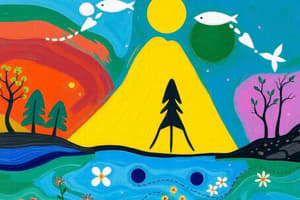Podcast
Questions and Answers
What are groundwater reservoirs known as?
What are groundwater reservoirs known as?
- Catchment areas
- Aquifers (correct)
- Watersheds
- Reservoir basins
What is the term for water that flows on top of the ground during heavy rainfall?
What is the term for water that flows on top of the ground during heavy rainfall?
- Groundwater
- Infiltration
- Subsurface flow
- Surface runoff (correct)
What are phosphate ions in ecosystems primarily found as?
What are phosphate ions in ecosystems primarily found as?
- Sulphate ions
- Nitrate ions
- Phosphate ions (PO43-) (correct)
- Potassium ions
Where are phosphates naturally found in significant amounts?
Where are phosphates naturally found in significant amounts?
What is the main role of decomposers in the phosphorus cycle?
What is the main role of decomposers in the phosphorus cycle?
How do plant roots utilize phosphates?
How do plant roots utilize phosphates?
Which process in the water cycle is responsible for moving shallow groundwater back to streams, rivers, lakes, and the ocean?
Which process in the water cycle is responsible for moving shallow groundwater back to streams, rivers, lakes, and the ocean?
How can artificial fertilizers impact the phosphorus cycle?
How can artificial fertilizers impact the phosphorus cycle?
What happens to the phosphates when plants and animals die?
What happens to the phosphates when plants and animals die?
What is one possible consequence of sewage containing animal waste entering water bodies?
What is one possible consequence of sewage containing animal waste entering water bodies?
Study Notes
Biogeochemical Cycles
The Carbon Cycle
- Carbon is the backbone of biological molecules, including carbohydrates, lipids, proteins, and nucleic acids.
- Carbon dioxide (CO2) is a gas in the atmosphere, making up around 0.04% of the gases.
- Plants and algae absorb CO2 through photosynthesis, producing glucose and storing carbon.
- Herbivores consume plants and algae, passing on stored carbon to their body mass.
- Respiration by living organisms releases CO2 back into the atmosphere.
- Decomposers break down dead organisms, releasing CO2 back into the atmosphere.
- Fossilization can produce fossil fuels, such as coal, oil, and gas, which are a store of carbon.
- Human activities, like burning fossil fuels, release CO2 into the atmosphere.
The Nitrogen Cycle
- Nitrogen is an essential component of proteins and nucleic acids, like DNA and RNA.
- Nitrogen is abundant in the atmosphere, but in a form that cannot be used by living organisms.
- Nitrogen fixation by bacteria converts nitrogen into ammonium ions (NH4+).
- Nitrification occurs in two stages: ammonium ions are converted into nitrites by Nitrosomonas, and then into nitrates (NO3-) by Nitrobacter.
- Plants absorb nitrates through assimilation, and animals consume them through the food chain.
- Decomposers break down nitrogen compounds into ammonium ions, which can be nitrified again.
- Denitrifying bacteria can convert nitrates back into nitrogen gas in anaerobic conditions.
The Water Cycle
- Water is essential for life, making up over 70% of cells.
- Water is a solvent, temperature buffer, and aids in aerobic cellular respiration.
- Most water is found as saltwater (97.5%), with only a small fraction available as freshwater.
- Liquid water is evaporated from oceans, lakes, and puddles by heat energy from the Sun, turning into water vapor.
- Water vapor cools and condenses back into water, forming clouds.
- Clouds can be blown by wind and transported to other areas, eventually releasing water as precipitation.
- Precipitation can be absorbed into the ground through percolation, or flow on the surface as surface runoff.
- Plants transport water from their roots to their leaves through the transpiration stream, eventually releasing it back into the atmosphere as water vapor.
The Phosphorus Cycle
- Phosphorus is a limiting nutrient in ecosystems, often in short supply.
- Phosphorus is found naturally as phosphate ions (PO43-), which form compounds with other elements.
- Phosphates are released into the soil through weathering and surface runoff.
- Plant roots absorb phosphates, which are passed on to animals through the food chain.
- Decomposers break down dead organisms, releasing phosphates back into the soil and water.
- Artificial fertilizers contain phosphates, which can enter waterways through surface runoff and sewage.
- Algae and other photosynthetic marine organisms take up dissolved phosphates, passing them on through marine food chains.
Studying That Suits You
Use AI to generate personalized quizzes and flashcards to suit your learning preferences.
Description
Explore the carbon cycle, a crucial biogeochemical process involving the movement of carbon within ecosystems. Learn about the role of carbon dioxide, its presence in the atmosphere, and its importance in biological molecules.




